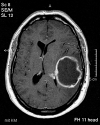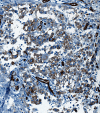A 28-year-old man with headache, visual and aphasic speech disturbances
- PMID: 19076784
- PMCID: PMC8094774
- DOI: 10.1111/j.1750-3639.2008.00241.x
A 28-year-old man with headache, visual and aphasic speech disturbances
Abstract
A 28-year-old man presented with a short history of headache, visual and aphasic speech disturbances. MR scans revealed a large, partly cystic, contrast-enhancing lesion of the left temporal lobe that upon microscopic examination was diagnosed as pleomorphic xanthoastrocytoma (PXA) with anaplastic features (WHO grade III). Remarkably, this tumor featured an unusual gliovascular, rosette-like histoarchitecture, which had previously been hypothesized to possibly indicate a greater likelihood of PXA recurrence. Indeed, only 14 months later, the patient presented with a recurrent lesion, which contained the previous histology, but now also featured a distinct fibrosarcoma-like component replete with numerous osteoclast-type giant cells. In addition, whereas eosinophilic granular bodies were plentiful at the lesion's periphery, numerous CD34 - positive satellite cells were found in the adjacent non-infiltrated cortex. Regarding the origin of this recurrent tumor and in reflection of its composition of distinct PXA as well as sarcomatous components, the diagnosis of a pleomorphic xanthoastrosarcoma, to be conceptually considered as a gliosarcoma subtype, was made.To our knowledge, this is an unprecedented case of sarcomatous transformation of a PXA. Particular attention should be given to gliovascular pseudopapillary structures in PXAs, the presence of which may potentially herald a more aggressive clinical behavior.
Figures
Similar articles
-
Malignant transformation of pleomorphic xanthoastrocytoma and differential diagnosis: case report.BMC Neurol. 2020 Jan 15;20(1):21. doi: 10.1186/s12883-020-1601-2. BMC Neurol. 2020. PMID: 31941461 Free PMC article.
-
Gliosarcoma associated with neurofibromatosis type I: a case report.Tumori. 2001 Jan-Feb;87(1):60-3. doi: 10.1177/030089160108700114. Tumori. 2001. PMID: 11669561
-
Gliosarcoma associated with a huge cyst--case report.Neurol Med Chir (Tokyo). 2000 Nov;40(11):581-4. doi: 10.2176/nmc.40.581. Neurol Med Chir (Tokyo). 2000. PMID: 11109796
-
Cerebellar pleomorphic xanthoastrocytoma in a patient with neurofibromatosis type 1: a case report and literature review.Int J Clin Exp Pathol. 2015 Jun 1;8(6):7570-4. eCollection 2015. Int J Clin Exp Pathol. 2015. PMID: 26261671 Free PMC article. Review.
-
Cerebellar pleomorphic xanthoastrocytoma in the setting of neurofibromatosis type-I: Does it portend a different prognosis? A case report and systematic review.Clin Neurol Neurosurg. 2021 Jan;200:106346. doi: 10.1016/j.clineuro.2020.106346. Epub 2020 Nov 2. Clin Neurol Neurosurg. 2021. PMID: 33160715
Cited by
-
Primary anaplastic pleomorphic xanthoastrocytoma in adults. Case report and review of literature.Int J Surg Case Rep. 2016;27:183-188. doi: 10.1016/j.ijscr.2016.08.022. Epub 2016 Aug 24. Int J Surg Case Rep. 2016. PMID: 27639203 Free PMC article.
-
Pleomorphic Xanthoastrocytoma: Natural History and Long-Term Follow-Up.Brain Pathol. 2015 Sep;25(5):575-86. doi: 10.1111/bpa.12217. Epub 2014 Dec 5. Brain Pathol. 2015. PMID: 25318587 Free PMC article.
-
A rare clinical presentation: a pleomorphic xanthoastrocytoma presenting with intracerebral haemorrhage and metastasizing vigorously-case report and review of the literature.Childs Nerv Syst. 2019 Feb;35(2):355-362. doi: 10.1007/s00381-018-3960-1. Epub 2018 Sep 4. Childs Nerv Syst. 2019. PMID: 30182181 Review.
-
Demography, Pattern of Care, and Survival in Patients with Xanthoastrocytoma: A Systematic Review and Individual Patient Data Analysis of 325 Cases.J Neurosci Rural Pract. 2019 Jul;10(3):430-437. doi: 10.1055/s-0039-1697873. Epub 2019 Oct 7. J Neurosci Rural Pract. 2019. PMID: 31595115 Free PMC article.
References
-
- Giannini C, Paulus W, Louis DN, Liberski P (2007) Pleomorphic xanthoastrocytoma. In: WHO Classification of Tumours of the Central Nervous System. Louis DN, Ohgaki H, Wiestler OD, Cavenee WK (eds), pp:22–24. IARC Press: Lyon.
-
- Primavera J, Nikas DC, Zamani AA, Shafman T, Alexander E, 3rd , De Girolami U, Louis DN (2001) Clear cell pleomorphic xanthoastrocytoma: case report. Acta Neuropathol 102:404–408. - PubMed
-
- Sugita Y, Shigemori M, Okamoto K, Morimatsu M, Arakawa M, Nakayama K (2000) Clinicopathological study of pleomorphic xanthoastrocytoma: correlation between histological features and prognosis. Pathol Int 50:703–708. - PubMed
Publication types
MeSH terms
Substances
LinkOut - more resources
Full Text Sources
Medical















